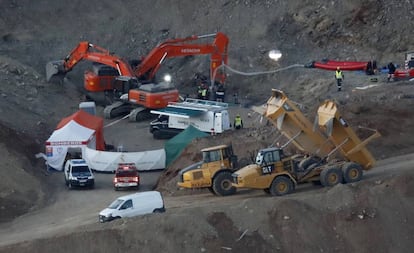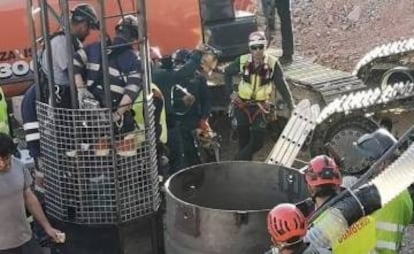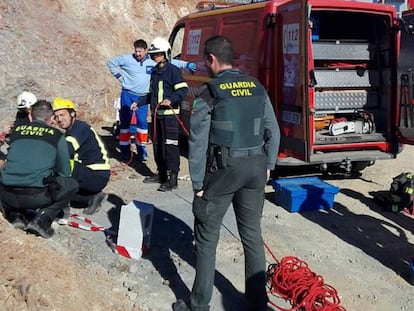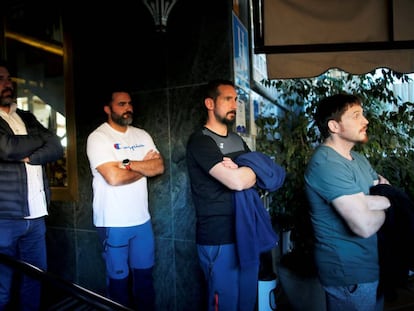One year on, uncertainty still hangs over Julen Roselló tragedy in Spain
The owner of the property where the toddler fell to his death down a narrow borehole will face trial on January 21

A year ago, the area known as Cerro de la Corona in Totalán, a hamlet of 715 residents in the southern Spanish province of Málaga, was home to olive trees, almond trees and a variety of shrubs. Now the ground is a stony field.
For 299 straight hours in January 2019, a dozen excavators and two drills ate away at the hillside, moving 17,000 tons of rocks in a race against the clock. Now, only the green shoots of a few newly growing olive trees lend some color to the 15,000-square-meter site. Here, under a sheet of iron, lies the borehole that kept Spaniards glued to their television screens for 13 days.
It was a tragedy, but we need to carry on
Resident of Totalán
The current silence is in sharp contrast with the incessant noise of the rescue equipment a year ago, as it sliced up the mountain in a desperate bid to find a little boy alive. Two-year-old Julen Roselló fell into a borehole with a diameter of no more than 25 centimeters on January 13, 2019 as he was playing on a relative’s rural property, where he and his family had been invited to spend the day. His body was found deep down the shaft following an unprecedented rescue operation involving engineers, explosives experts and specialized miners brought in from northern Spain.
The autopsy showed the cause of death to have been a 71-meter free fall down the narrow unmarked hole, which had been drilled in search of underground water. This is one of the few certainties in a case that will be tried in a Málaga court, where the first hearing is scheduled for January 21.
The only individual who will stand trial is David Serrano, the property owner, who was also the only person there that day who knew about the existence of the borehole. He is being accused of negligent homicide, and faces between three and three-and-a-half years in prison if found guilty. He is also being asked for €1.5 million in damages; Serrano claimed insolvency but his request was denied.

When the more than 200 reporters who covered the rescue effort left the area, after publishing hundreds of articles and providing 228 hours of television coverage, the machines remained in Totalán for a few more days in an attempt to return the hill to its original state. The borehole where the toddler “disappeared,” as his parents Victoria García and José Roselló described it, has been covered up for good. And the local residents, who organized themselves into committees to feed, house and assist the hundreds of volunteers who descended on the village, would rather move on now. “It was a tragedy, but we need to carry on,” says one senior citizen walking along Paseo de la Salud.
“The feeling is strange, very strange,” says Ángel García Vidal, the engineer who spontaneously stepped up to lead the complex, unplanned rescue operation. García Vidal returned to the site just a few weeks ago. “The first thing that came to mind was the enormous effort that took place, and the repercussion it had. I wasn’t fully aware of it. And this year has given me some perspective on the sacrifice and work of those days.” It took him six months to go back to the daily routine at his office, he admits.
Like him, another 300 experts in various fields contributed to the rescue effort. “There’s been enough time now to think about what could have been done better in such an extreme and unique situation,” adds Julián Moreno, who was technical director of Málaga’s firefighter department at the time. He has not returned to Totalán, “but what happened there stays in your head; it will still be some time before we manage to move on.”
I still have a strange feeling. The experience has marked me for life
Francisco Manuel Alonso, geologist
“We did what we could, and we would have liked a different ending,” adds Sergio Tuñón, head of the Mining Rescue Brigade. “We always worked with the hope that he was still alive. It was difficult, but not impossible,” says Francisco Manuel Alonso, a geologist from Huelva University who helped the team understand the terrain they were working with. “I still have a strange feeling. The experience has marked me for life.”
A Málaga judge named Elena Sancho Mallorquín will oversee the trial, which has attracted so much media interest that a special room has been reserved for the press. The six hearings will seek to clarify two main points: whether Serrano did or did not warn Julen’s parents about the existence of the borehole (he said that he did, the parents deny it); and whether the opening was covered. A few days after the accident, Serrano gave a news conference at which he claimed that the borehole had been covered with two concrete blocks and that the child slipped between them. But Antonio Sánchez – the man who was hired to make the hole – said it was not. The defense has claimed that Sánchez should be held responsible for not taking the proper safety precautions. Serrano’s attorneys have also tried to shift the blame to Julen’s parents, saying “they should have been alert to the child’s movements.”
The parents are pushing for the highest prison sentence, three and a half years, claiming that Serrano “completely disregarded safety norms” and that if only he had taken a few basic steps, their son’s death could have been avoided.
English version by Susana Urra.
Tu suscripción se está usando en otro dispositivo
¿Quieres añadir otro usuario a tu suscripción?
Si continúas leyendo en este dispositivo, no se podrá leer en el otro.
FlechaTu suscripción se está usando en otro dispositivo y solo puedes acceder a EL PAÍS desde un dispositivo a la vez.
Si quieres compartir tu cuenta, cambia tu suscripción a la modalidad Premium, así podrás añadir otro usuario. Cada uno accederá con su propia cuenta de email, lo que os permitirá personalizar vuestra experiencia en EL PAÍS.
¿Tienes una suscripción de empresa? Accede aquí para contratar más cuentas.
En el caso de no saber quién está usando tu cuenta, te recomendamos cambiar tu contraseña aquí.
Si decides continuar compartiendo tu cuenta, este mensaje se mostrará en tu dispositivo y en el de la otra persona que está usando tu cuenta de forma indefinida, afectando a tu experiencia de lectura. Puedes consultar aquí los términos y condiciones de la suscripción digital.
More information
Archived In
Últimas noticias
Welcome to the post-religion era: The idea of Christianity as the absolute truth has become obsolete
‘I thought you would like it’: The risky sexual practice popularized by TV shows and TikTok
The digitalization of tourism: ‘They promise experiences and gave us the worst possible one’
Mexican peso defies uncertainty with forecasts of a new period of stability in 2026
Most viewed
- Sinaloa Cartel war is taking its toll on Los Chapitos
- Reinhard Genzel, Nobel laureate in physics: ‘One-minute videos will never give you the truth’
- Oona Chaplin: ‘I told James Cameron that I was living in a treehouse and starting a permaculture project with a friend’
- Why the price of coffee has skyrocketed: from Brazilian plantations to specialty coffee houses
- Silver prices are going crazy: This is what’s fueling the rally











































